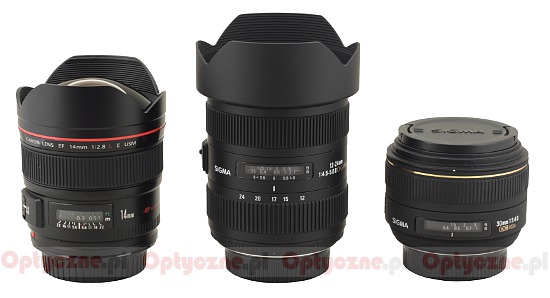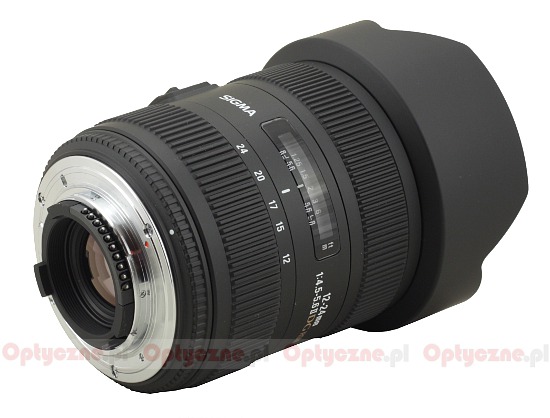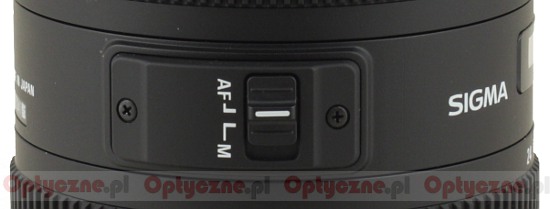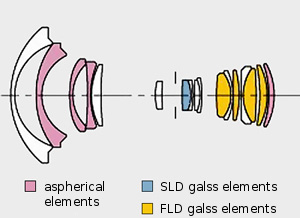Sigma 12-24 mm f/4.5-5.6 II DG HSM
3. Build quality
In the photo below the Sigma 12-24 mm is positioned next to the Canon EF 14 mm f/2.8L USM II and the Sigma 1.4/30.
 |
Please Support UsIf you enjoy our reviews and articles, and you want us to continue our work please, support our website by donating through PayPal. The funds are going to be used for paying our editorial team, renting servers, and equipping our testing studio; only that way we will be able to continue providing you interesting content for free. |
- - - - - - - - - - - - - - - - - - - - - - - - - - - - - - - - - - - - - - - - - - - - - - - -
The previous 12-24 mm model belonged to the top-of-the-range Sigma series marked by the EX symbol. The new version doesn’t have that mark anymore but only because of the new Sigma’s policy, according to which the EX letters are reserved only for the best fixed focal lenses and zoom lenses with a fixed aperture. The Sigma 12-24 mm II is not a fixed aperture zoom lens so it doesn’t deserve the EX mark. It doesn’t mean, however, that it is made worse than its predecessor – in fact its workmanship is beyond reproach.
The lens starts with a metal mount with contacts – it surrounds a rear element which is 26 mm in diameter and changes its position with the change of the focal length. At 12 mm it is situated almost on the same level as the mount and at 24 mm it hides inside the casing a bit more than 1.5 cm deep. The movement of the element doesn’t cause any creaks so dust and other dirt shouldn’t be sucked inside the construction.
 |
The proper casing of the lens starts with a narrow immobile ring on which there is a white dot making the attachment to a body easier. Immediately afterwards we find a zoom ring, 27 mm wide. It is covered by rubber ribs and has markings for 12, 15, 17, 20 and 24 mm focal length. The ring moves smoothly and is well-damped – its work would be difficult to fault.
Further on we see a distance scale behind a window, expressed in feet and meters. What’s interesting, the scale includes depth of field markings for f/8.0 and f/5.6 aperture as well. It is not known at what focal length, though – most likely the shortest one. On the left side of the scale there is a manual focus mechanism mode switch (AF/MF). Even a bit further there is a serial number of the lens and the info that it was produced in Japan.
 |
The next element is a manual focus ring, 26 mm wide and partially covered by rubber ribbing. It moves smoothly and is well-damped. Running through the whole distance scale takes a turn through 135 degrees. It can work in AF and MF mode as well, offering you a great working precision.
The manual focus ring turns almost smoothly into a built-in petal type hood which surrounds the front, convex element 48 mm in diameter. The element changes its position with the focal length change. At 12 mm it is the most extended, then it starts to hide, being the deepest inside at a focal length near 20 mm and then it starts to extend again. This movement is, all in all, hardly distinguishable and it doesn’t cause any gaps in the casing through which dirt could penetrate the lens.
Producing such a lens as the Sigma 12-24 mm is certainly not an easy task. If it was, there would be more similar constructions on the market. The optical construction of the lens might indicate the scale of the problem. We deal here with 17 elements positioned in 13 groups. The number of special elements is really impressive – inside the construction you can find as many as four aspherical elements (including 3 made in the “glass mold” technology and an aspherical one) and five low-dispersion elements (four made of FLD fluoride glass and one SLD element). Inside there is also an aperture with six diaphragm blades which can be closed down to f/22-29, depending on the focal length.

The buyer gets both caps, a built-in hood and a hard case included in the box.
 |






